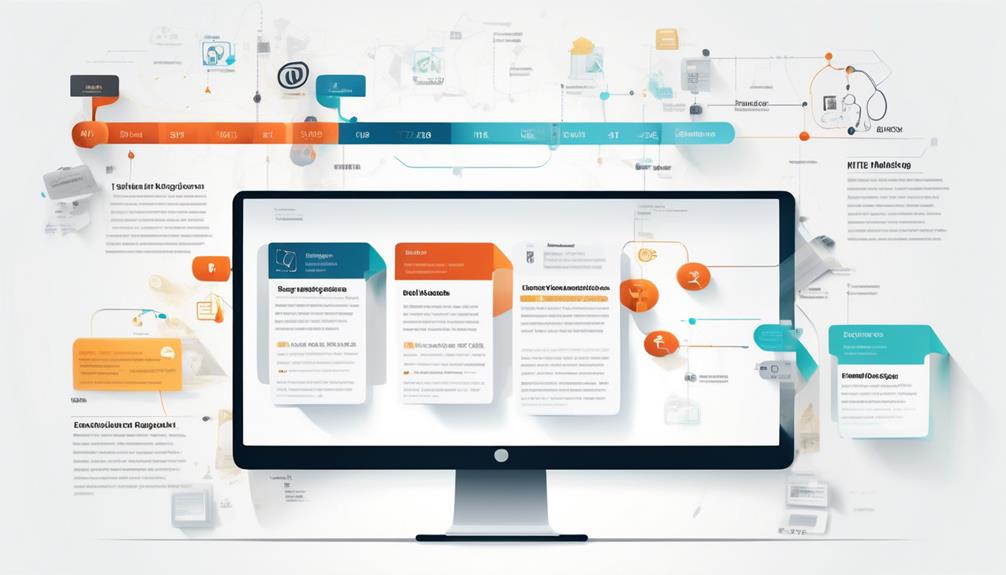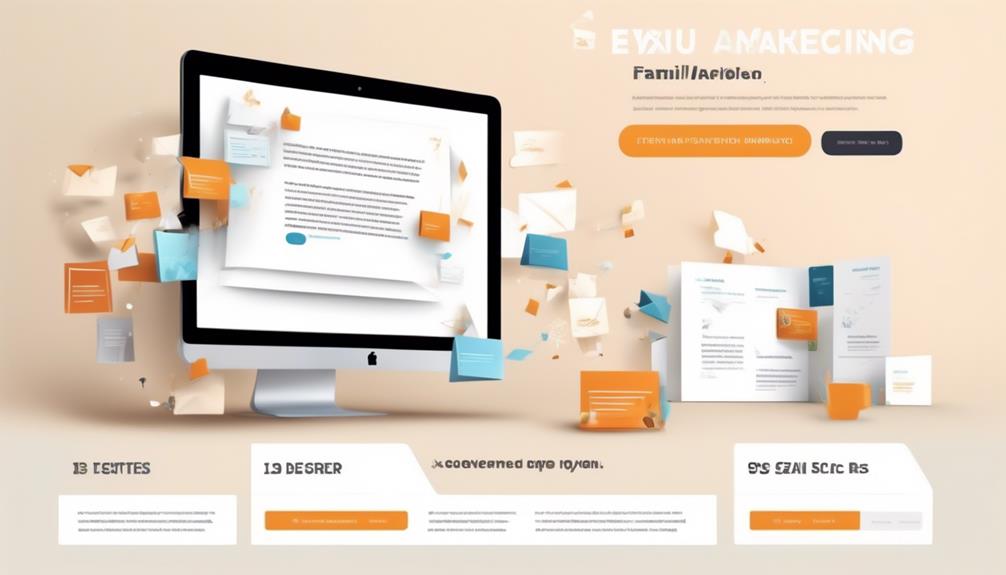Email marketing has been around much longer than people think, dating back to the late 1970s. The story of its development goes hand in hand with the rise of the internet, revealing a fascinating journey. Learn how this modern concept actually has deep roots in history and discover the surprising connections between email marketing and the internet boom. Dive into this captivating tale to uncover the hidden history behind email marketing!
Understanding this history can provide valuable insights into the current state of email marketing and its potential future trajectory. Join us as we explore the intriguing story of when and how email marketing first began, uncovering the pivotal moments that have shaped its course over the years.
Key Takeaways
- Email marketing began in 1978 with Gary Thuerk's successful campaign, generating $13 million in sales.
- The first email, sent by Ray Tomlinson in 1971, laid the foundation for future marketing emails and campaigns.
- The introduction of Hotmail in 1996 revolutionized email marketing by making personal email accounts accessible to a broader audience.
- The Can-Spam Law in 2003 imposed regulations on commercial emails, shaping email marketing strategies and best practices.
Origins of Email Communication
In 1971, with the first email sent by Ray Tomlinson, the origins of email communication were established, marking the inception of a revolutionary form of digital interaction.
This event laid the foundation for the evolution of email marketing campaigns. Seven years later, in 1978, Gary Thuerk conducted the first-ever email marketing campaign, which generated an impressive $13 million in sales.
However, the journey of email marketing wasn't without its challenges. The term 'spam' was added to the Oxford English Dictionary in 1988, reflecting the obstacles faced by marketers in utilizing email as a marketing tool.
The landscape of email marketing transformed significantly with the advent of the internet in 1991, offering marketers a platform for widespread communication with users. The launch of Hotmail in 1996 further revolutionized email marketing by making personal email accounts accessible to everyone.
These milestones in the history of email marketing paved the way for digital marketers to harness the power of email as a pivotal tool for engaging with a broad audience.
The First Email

With the foundation established by Ray Tomlinson's groundbreaking first email in 1971, the evolution of email communication set the stage for the pioneering efforts in email marketing. The first email, sent by Ray Tomlinson, was a modest yet revolutionary event that sparked the beginning of a global shift in communication. This watershed moment laid the groundwork for the future of digital marketing and the concept of reaching potential customers through electronic mail.
Ray Tomlinson's email not only marked the inception of email communication but also sowed the seeds for the future integration of marketing into this platform. This pioneering email laid the groundwork for all future marketing emails and campaigns, shaping the way businesses connect with their audience. The impact of this first email can't be overstated, as it led to the development of an industry that now reaches billions of email users worldwide.
The significance of this moment is underscored by the subsequent evolution of email marketing, with Gary Thuerk's 1978 campaign resulting in $13 million in sales, setting a precedent for the efficacy of email marketing campaigns. This momentous occasion paved the way for the multibillion-dollar email marketing industry we know today.
Development of Email Management Systems
As we continue our exploration of email marketing history, it's crucial to understand the development of email management systems.
Early email systems laid the groundwork for the evolution of email platforms, shaping the way we manage and utilize this communication tool.
Examining the progression of these systems provides valuable insights into the technological advancements that have influenced email marketing over the years.
Early Email Systems
The development of email management systems saw significant advancements with the launch of Lotus Notes in 1989, marking a pivotal moment in the history of email. This innovation allowed for the management of emails, calendars, and collaborative content.
The introduction of the internet and the widespread use of Digital Equipment Corporation (DEC) machines further accelerated the evolution of email systems, enabling seamless communication and collaboration. Moreover, the foundation laid by Ray Tomlinson's first email in 1971 set the stage for the exponential growth of electronic mail.
Gary Thuerk's pioneering email marketing campaign in 1978 also demonstrated the potential of emails for commercial purposes, leading to significant developments in marketing strategies. These early email systems laid the groundwork for the sophisticated email management systems we use today.
Evolution of Email Platforms
Remarkably, the evolution of email platforms has been marked by significant advancements in the development of email management systems, revolutionizing the way we communicate and collaborate.
The launch of Hotmail in 1996 played a pivotal role in making personal email accounts accessible to a broader audience, thereby transforming the landscape of email marketing and digital marketing. This led to a surge in the number of American internet users and the widespread adoption of email campaigns as a powerful tool for businesses.
Furthermore, the introduction of the Can-Spam Law in 2003 imposed regulations on commercial emails, significantly impacting the development of email marketing strategies.
Subsequently, the introduction of responsive emails in 2009 further enhanced the evolution of email platforms by enabling seamless transfer across devices and improving the overall user experience.
Emergence of Email Marketing

We'll start by exploring the earliest instances of email advertising and its evolution into a direct marketing tool.
The first email campaigns, including Gary Thuerk's pioneering effort in 1978, played a pivotal role in shaping the landscape of digital marketing.
Additionally, we'll examine the impact of Hotmail's widespread accessibility in 1996 on the strategies and reach of email marketing.
Early Email Advertising
In 1978, Gary Thuerk conducted the first-ever email marketing campaign, which resulted in $13 million in sales, marking a significant milestone in the emergence of email advertising. This event paved the way for the use of email as a marketing tool.
Key points to consider in the emergence of early email advertising include:
- Thuerk's campaign leveraged the Advanced Research Projects Agency Network (ARPANET) at MIT to send unsolicited commercial emails to 400 potential clients.
- This approach laid the foundation for the development of a structured email marketing program and highlighted the potential of email as a key marketing strategy.
- The success of this campaign prompted businesses to explore the possibilities of utilizing email for targeted marketing, leading to the evolution of modern email marketing techniques.
Direct Marketing via Email
The groundbreaking success of Gary Thuerk's pioneering email marketing campaign in 1978 set the stage for the emergence of direct marketing via email as a powerful and influential tool in the world of advertising. Following this, in 1971, Ray Tomlinson sent the first email, marking the inception of direct marketing via email.
The term 'spam' was officially recognized in 1988, reflecting the commercial use of email marketing. The Can-Spam Act of 2003 was a significant milestone, establishing regulations for commercial emails, shaping marketing best practices.
Subsequently, in 2009, the introduction of responsive emails enhanced email deliverability, revolutionizing marketing strategies. These chronological developments underscore the evolution of direct marketing via email, demonstrating its adaptability and influence in the ever-changing landscape of advertising.
First Email Campaigns
Marking a pivotal moment in the history of marketing, the first email campaigns spearheaded a new era of direct communication and advertising, revolutionizing the way businesses engage with their audience.
- Gary Thuerk's 1978 email blast stands as the first mass email campaign, resulting in $13 million in sales and laying the foundation for modern email marketing.
- The term 'spam' was added to the Oxford English Dictionary in 1988, reflecting the negative connotation associated with unsolicited marketing emails.
- This groundbreaking approach to marketing emails led to the development of email lists, creating a direct channel to reach potential customers and establish brand connections.
These milestones not only marked the emergence of email marketing but also set the stage for the evolution of regulations, responsive design, and the continuous innovation of email marketing strategies.
Evolution of Email Formats

The evolution of email formats has been marked by significant advancements in usability and adaptability, transforming the way marketers engage with their audiences.
Since the introduction of email marketing in 1978, the format of marketing emails has undergone substantial changes. The advent of the internet in 1991 expanded the potential reach of marketing messages. However, it was the Can-Spam Law in 2003 that shaped the format and content of marketing emails by setting regulations for commercial emails, ensuring that personal data was handled appropriately.
The introduction of responsive emails in 2009 was a pivotal moment, allowing seamless transfer across devices and revolutionizing the email format. This advancement made marketing emails more accessible and user-friendly, enhancing their effectiveness as marketing channels.
Furthermore, the evolution of email formats has aligned with the broader shift in email marketing from mass marketing to a strategy for customer and brand development. This has led to the utilization of personal data and Marketing Automation for targeted communication, emphasizing the adaptability and potential of email messages in modern marketing strategies.
Regulatory Milestones in Email Marketing

Pivoting from the evolution of email formats, the regulatory milestones in email marketing have played a crucial role in shaping the landscape of digital communication and advertising strategies.
- Can-Spam Law (2003): This landmark legislation set the first national standards for the sending of commercial email and required the inclusion of an unsubscribe link, influencing the way businesses engage with commercial email addresses. The law aimed to protect personal email addresses from unsolicited and potentially harmful content, setting a precedent for future regulations. It established guidelines for sending commercial messages to the general public, emphasizing the importance of obtaining consent and providing a clear opt-out method.
- Introduction of Responsive Emails (2009): The advent of responsive emails revolutionized email marketing by ensuring that messages could adapt to various devices, enhancing the user experience for both commercial and personal email addresses. This development enabled marketers to reach a wider audience and deliver more engaging content, driving the evolution of email marketing strategies. It marked a pivotal moment in the industry's efforts to optimize the delivery of marketing messages to consumers' inboxes.
- Impact of Pandemic (2020): The pandemic led to the implementation of new laws requiring consent before emailing contacts, further shaping the regulatory landscape of email marketing. These regulations underscored the significance of obtaining explicit consent from recipients, signaling a shift towards more stringent measures to protect individuals' inboxes and privacy.
Advancements in Email Design

With the rapid evolution of email design in the 21st century, advancements have been driven by technological growth and the need to overcome challenges posed by spam filters and removal software. As email marketing faced increasing scrutiny and users labeled marketing emails as spam, designers had to innovate to bypass filters and capture the attention of potential customers.
Marketers began focusing on creating interactive and engaging email designs to stand out in crowded inboxes and improve open rates. Responsive email design has become crucial, allowing seamless transfer across devices and enhancing the user experience. This shift in design approach has led to the incorporation of graphics, video, dynamic content, and interactivity in email marketing, aiming to enhance engagement and drive click-through rates.
This evolution reflects the ongoing need to adapt to changing consumer behaviors and preferences. As email design continues to advance, marketers are leveraging the English Dictionary of design elements to create compelling and visually appealing emails that resonate with their target audience.
Email Marketing in the Modern Era

Email marketing has undergone significant transformations in the modern era, adapting to technological advancements and shifting consumer behaviors. This evolution has been marked by several key developments:
- Integration with Social Media
- Email marketing has seamlessly integrated with social media platforms, allowing for cross-channel promotion and audience engagement.
- This integration has enabled marketers to leverage the power of social media to expand the reach and impact of their email campaigns.
- Enhanced Email Services
- Modern email marketing platforms offer advanced automation, personalization, and analytics capabilities.
- These features have empowered marketers to create highly targeted and personalized campaigns, leading to greater marketing success.
- Focus on ROI
- In the modern era, email marketing has proven to deliver the highest return on investment (ROI) of any marketing channel.
- Marketers have shifted their strategies to prioritize email marketing due to its proven track record of delivering tangible results.
These advancements in the modern era have solidified email marketing as a vital component of successful marketing strategies, showcasing its adaptability and effectiveness in the ever-evolving digital landscape.
:How Has Email Marketing Evolved in Terms of Legal Compliance?
Email marketing legality explained has evolved over the years due to stricter regulations like the GDPR and CAN-SPAM Act. Marketers now must ensure proper consent, include opt-out options, and provide clear disclosures. Failure to comply can result in hefty fines and damage to brand reputation.
Frequently Asked Questions
When Did Email Start Being Widely Used?
We often overlook the pivotal shift in communication.
The widespread use of email began in the 1990s with the introduction of Hotmail, making personal email accounts accessible to all. This accessibility facilitated the explosion of email marketing, transforming it into a powerful tool for businesses.
The evolution of email usage, from its early stages in the 1970s to its mass adoption in the 1990s, has significantly impacted the way we interact and conduct business.
Who Invented Email Marketing?
We believe Gary Thuerk conducted the first-ever email marketing campaign in 1978.
The term 'spam' was later added to the Oxford English Dictionary in 1988.
Regulations for commercial emails were set by the Can-Spam Law in 2003.
Responsive emails, introduced in 2009, allowed seamless transfer across devices.
Hotmail, launched in 1996, made personal email accounts accessible to everyone.
Is Email Marketing the Oldest Form of Digital Marketing?
Email marketing is indeed the oldest form of digital marketing. From its humble beginnings in the 1970s to the innovative campaigns of today, email has stood the test of time. Its adaptability and reach have made it a cornerstone of digital marketing strategies.
As the digital landscape continues to evolve, email marketing remains a powerful tool for engaging with audiences and driving results.
Is Email Marketing Obsolete?
No, email marketing isn't obsolete. It has continually evolved to adapt to changing consumer behaviors and technological advancements. With the rise of personalization, automation, and segmentation, email marketing remains a critical strategy for driving high return on investment, building brand awareness and loyalty, and driving website traffic and conversions.
It has proven to be a resilient and effective marketing avenue, demonstrating its ongoing relevance in the digital marketing landscape.
Conclusion
In conclusion, email marketing has come a long way since its inception in 1978. With billions of email users worldwide, it remains a powerful tool in the marketing industry.
One interesting statistic is that the average return on investment for email marketing is $42 for every $1 spent, making it one of the most cost-effective marketing mediums available today.
As technology continues to advance, email marketing will continue to evolve and adapt to the changing needs of consumers.










